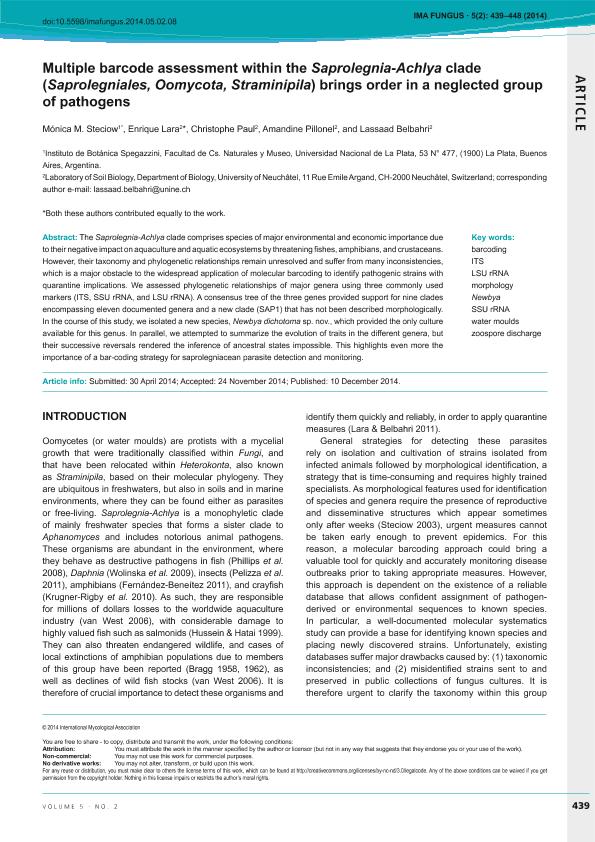Mostrar el registro sencillo del ítem
dc.contributor.author
Steciow, Mónica Mirta

dc.contributor.author
Lara, Enrique
dc.contributor.author
Paul, Christophe
dc.contributor.author
Pillonel, Amandine
dc.contributor.author
Belbahri, Lassaad
dc.date.available
2018-01-22T19:22:19Z
dc.date.issued
2014-12
dc.identifier.citation
Steciow, Mónica Mirta; Lara, Enrique; Paul, Christophe; Pillonel, Amandine; Belbahri, Lassaad; Multiple barcode assessment within the Saprolegnia-Achlya clade (Saprolegniales, Oomycota, Straminipila) brings order in a neglected group of pathogens; International Mycological Association; IMA Fungus; 5; 2; 12-2014; 439-448
dc.identifier.issn
2210-6340
dc.identifier.uri
http://hdl.handle.net/11336/34156
dc.description.abstract
The Saprolegnia-Achlya clade comprises species of major environmental and economic importance due to their negative impact on aquaculture and aquatic ecosystems by threatening fishes, amphibians, and crustaceans. However, their taxonomy and phylogenetic relationships remain unresolved and suffer from many inconsistencies, which is a major obstacle to the widespread application of molecular barcoding to identify pathogenic strains with quarantine implications. We assessed phylogenetic relationships of major genera using three commonly used markers (ITS, SSU rRNA, and LSU rRNA). A consensus tree of the three genes provided support for nine clades encompassing eleven documented genera and a new clade (SAP1) that has not been described morphologically. In the course of this study, we isolated a new species, Newbya dichotoma sp. nov., which provided the only culture available for this genus. In parallel, we attempted to summarize the evolution of traits in the different genera, but their successive reversals rendered the inference of ancestral states impossible. This highlights even more the importance of a bar-coding strategy for saprolegniacean parasite detection and monitoring.
dc.format
application/pdf
dc.language.iso
eng
dc.publisher
International Mycological Association
dc.rights
info:eu-repo/semantics/openAccess
dc.rights.uri
https://creativecommons.org/licenses/by/2.5/ar/
dc.subject
Barcoding
dc.subject
Its
dc.subject
Lsu Rrna
dc.subject
Morphology
dc.subject
Newbya
dc.subject
Ssu Rrna
dc.subject
Water Moulds
dc.subject
Zoospore Discharge
dc.subject.classification
Otras Ciencias Biológicas

dc.subject.classification
Ciencias Biológicas

dc.subject.classification
CIENCIAS NATURALES Y EXACTAS

dc.title
Multiple barcode assessment within the Saprolegnia-Achlya clade (Saprolegniales, Oomycota, Straminipila) brings order in a neglected group of pathogens
dc.type
info:eu-repo/semantics/article
dc.type
info:ar-repo/semantics/artículo
dc.type
info:eu-repo/semantics/publishedVersion
dc.date.updated
2018-01-15T17:36:18Z
dc.journal.volume
5
dc.journal.number
2
dc.journal.pagination
439-448
dc.journal.pais
Reino Unido

dc.description.fil
Fil: Steciow, Mónica Mirta. Universidad Nacional de la Plata. Facultad de Ciencias Naturales y Museo. Instituto de Botánica Spegazzini; Argentina. Consejo Nacional de Investigaciones Científicas y Técnicas; Argentina
dc.description.fil
Fil: Lara, Enrique. Universite de Neuchatel; Suiza
dc.description.fil
Fil: Paul, Christophe. Universite de Neuchatel; Suiza
dc.description.fil
Fil: Pillonel, Amandine. Universite de Neuchatel; Suiza
dc.description.fil
Fil: Belbahri, Lassaad. Universite de Neuchatel; Suiza
dc.journal.title
IMA Fungus
dc.relation.alternativeid
info:eu-repo/semantics/altIdentifier/doi/http://dx.doi.org/10.5598/imafungus.2014.05.02.08
dc.relation.alternativeid
info:eu-repo/semantics/altIdentifier/url/http://www.ingentaconnect.com/content/ima/imafung/2014/00000005/00000002/art00017
Archivos asociados
